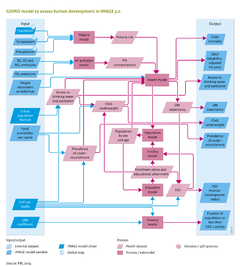Human development: Difference between revisions
Jump to navigation
Jump to search
Oostenrijr (talk | contribs) m (Text replace - "SO2" to "SO<sub>2</sub>") |
Oostenrijr (talk | contribs) m (Text replace - "NOx" to "NO<sub>x</sub>") |
||
| Line 4: | Line 4: | ||
|Model-Database=GUAM model; World Bank database; FAOSTAT database; WHO database; | |Model-Database=GUAM model; World Bank database; FAOSTAT database; WHO database; | ||
|KeyReference=Hilderink and Lucas, 2008; PBL, 2012; PBL, 2009; | |KeyReference=Hilderink and Lucas, 2008; PBL, 2012; PBL, 2009; | ||
|InputVar=Temperature - grid; Precipitation - grid; Food availability per capita; GINI coefficient; GDP per capita; People dependent on solid fuel; BC, OC and | |InputVar=Temperature - grid; Precipitation - grid; Food availability per capita; GINI coefficient; GDP per capita; People dependent on solid fuel; BC, OC and NO<sub>x</sub> emissions; SO<sub>2</sub> emissions; Population - grid; Urban population fraction; | ||
|OutputVar=Child mortality; Life expectancy; DALYs (disability-adjusted life years); Access to drinking water and sanitation; HDI (human development index); Child underweight; Prevalence of undernourishment; People living on less then USD 1.25 per day; | |OutputVar=Child mortality; Life expectancy; DALYs (disability-adjusted life years); Access to drinking water and sanitation; HDI (human development index); Child underweight; Prevalence of undernourishment; People living on less then USD 1.25 per day; | ||
|Description=The quantity and quality of accessible environmental resources determine the viability of livelihoods. Unequal access to, and diminished quality of resources have a significant effect on livelihoods and on human health, particularly in developing countries. Increasing world population accompanied by rising demand for food, water and energy will put even more pressure on scarce natural resources, such as fertile land, potable water and forest resources. The pressure will be even greater in areas where natural resources are not well managed and or where degraded as a result of global environmental change. | |Description=The quantity and quality of accessible environmental resources determine the viability of livelihoods. Unequal access to, and diminished quality of resources have a significant effect on livelihoods and on human health, particularly in developing countries. Increasing world population accompanied by rising demand for food, water and energy will put even more pressure on scarce natural resources, such as fertile land, potable water and forest resources. The pressure will be even greater in areas where natural resources are not well managed and or where degraded as a result of global environmental change. | ||
Revision as of 10:38, 1 July 2014
Parts of Human development
| Component is implemented in: |
|
| Related IMAGE components |
| Projects/Applications |
| Models/Databases |
| Key publications |
Key policy issues
- What are the key future trends in human development, such as those targeted by the Millennium Development Goals (MDGs)?
- How are changes in the global environment likely to affect human development?
- How is improved access to food, water and energy likely to contribute to human development?
Introduction
<ul><li>Property "HasInputVar" (as page type) with input value "BC, OC and NOx emissions" contains invalid characters or is incomplete and therefore can cause unexpected results during a query or annotation process.</li> <!--br--><li>Property "HasInputVar" (as page type) with input value "SO2 emissions" contains invalid characters or is incomplete and therefore can cause unexpected results during a query or annotation process.</li></ul>
